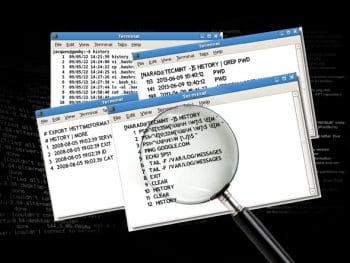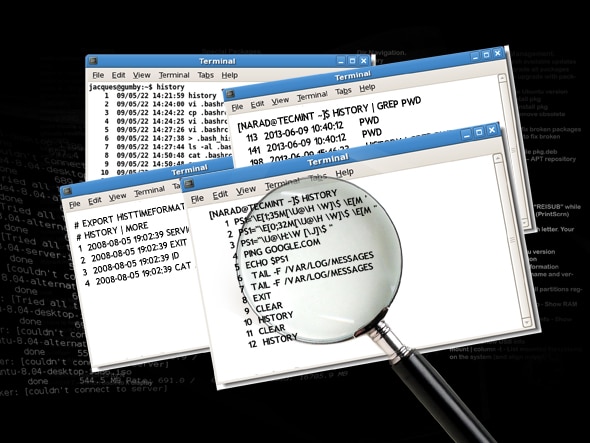
Linux users have to make use of the command line at one time or the other. The History command saves them from repeatedly typing certain commands. This article will help readers to leverage the History operations available.
While working with the GNU/Linux environment, one is forced to spend some time on the command line. One is likely to repeat common commands often, and typing variations on those commands even more frequently. This can be good practice in the beginning but later it gets annoying and the repetition of commands slows one down.
Luckily, we can save some time with the use of the History command and its variations.
In this section, we will look at how we can explore this command. For this demonstration, I am using Ubuntu 14.04 LTS, but the process is the same for most GNU/Linux distributions.
Using the History command
The GNU/Linux History library is able to keep track of all the previously executed commands and this information can be helpful in writing new ones and executing them. The History command can be used to list a log of the commands you have typed.
This log is called the history. And the command used to access it is history.
[bash]$ history599 cat .bashrc600 nautilus601 vi602 ls -l |
In the above output, the former parameter is the command number in the History file and the latter is the actual command.
This will list all the previously executed commands.
Typing history n will list the last n commands from the log.
The following command will list the last five commands from the history log.
[bash]$ history 5599 cat .bashrc600 nautilus601 vi602 ls -l603 history |
The following are some keys to scroll through the history and jump to either end:
UP arrow key: Scrolls backwards in history.
CTRL + p: Scrolls backwards in history.
DOWN arrow key: Scrolls forward in history.
CTRL + n: Scrolls forward in history.
ALT+Shift+.: Jumps to the end of the history.
ALT+Shift+,: Jumps to the beginning of the history.
Variables configuration
The behaviour of the history log file is controlled by a few variables and these can be found or can be added to the .bashrc file. So let us have a look at the .bashrc file. This is present in the home directory. To view its contents, open a terminal and fire up the cat command followed by the name (i.e., cat .bashrc) or simply navigate to the home directory and press CTRL+h and open it with the text editor. Lets review some of the variables.
HISTCONTROL: Now, it would make sense if you keep some of the variables values as they are, by default, like the value of the variable HISTCONTROL=ignoreboth (which will avoid duplication of commands) and shopt -s histappend (which will append newly executed commands to the previous history).
Although HISTCONTROL=ignoreboth is good enough for us, some of the other possible values for HISTCONTROL along with the syntax are:
[bash]$ export HISTCONTROL=ignoredups |
(To eliminate duplicates, set HISTCONTROL to ignoredups)
[bash]$ export HISTCONTROL=erasedups |
(To eliminate duplicates across the whole history, set the HISTCONTROL to erasedups)
[bash]$ export HISTCONTROL=ignorespace |
(When you execute a command, you can instruct history to ignore the command by setting HISTCONTROL to ignorespace and typing a space in front of the command)
HISTSIZE and HISTFILESIZE: Some of the other variables in the .bashrc file are HISTSIZE and HISTFILESIZE.
- HISTSIZE is the number of lines of the command to store in the history list (i.e., in the memory)
- HISTFILESIZE is the number of lines of the command to store in history file (i.e., the actual history file)
These variables are set to an integer value. To change these values, use the following command:
[bash]$ export HISTSIZE=2000[bash]$ export HISTFILESIZE=2000 |
HISTSIZE can be used to disable the use of history.
If you want to disable history all together and dont want bash shell to remember the commands youve typed, set the HISTSIZE to 0 as shown below:
[bash]$ export HISTSIZE=0 |
Note that now history will not display anything.
HISTFILE: The HISTFILE variable can be used to store the history log to an alternate file. To do so, execute the following command:
[bash]$ export HISTFILE=.bash_alternate_history |
Now the history will be stored in .bash_alternate_history.
HISTTIMEFORMAT=%F %T: Typically, when you type history from the command line, it displays the previously executed commands, but sometimes it may be beneficial to display the time stamp along with the command. To do so, execute the following command:
[bash]$ export HISTTIMEFORMAT=%F %T |
Now, on executing the history command, the execution date and time along with the command will be displayed:
[bash]$ history16 2014-11-09 17:51:11 ll17 2014-11-09 17:54:32 cd ..13 2014-11-09 17:57:37 pwd14 2014-11-09 17:58:47 history |
HISTIGNORE: Sometimes you may not want your history to remember some basic commands such as ls. Use HISTIGNORE to specify all the commands that you want to ignore from the history. Please note that adding ls to the HISTIGNORE ignores only ls and not ls -l. So, we have to be specific about the command that we would like to ignore from the history. Thus, executing the following command will ignore ls and ls -l commands:
[bash]$ export HISTIGNORE=ls:ls -l: |
Note: 1) Sometimes you may be required to re-login for the changes to take effect.
2) To make permanent changes, add the variables with their values in the .bashrc file and re-login for the changes to take effect.
Event designators for history
Consider the history log for the upcoming event designator examples:
[bash]$ history1 pwd2 ls3 cd Documents/4 ll5 nautilus6 history!n |
The above executes command number n.
[bash]$ !1pwd/home/christmas/Documents!-n |
This executes current command minus n.
[bash]$ !-3total 1648drwxr-xr-x 5 christmas christmas 4096 Nov 6 11:48 ./drwxr-xr-x 35 christmas christmas 4096 Nov 8 18:34 ../-rw-rw-r-- 1 christmas christmas 8164 Nov 4 19:05 24914.png-rw-rw-r-- 1 christmas christmas 27817 Nov 5 12:05 400_F_37625904_mNllKUnYH3cnVRKPlankmHzcz1zwlSjN.jpg!! |
This executes the previous command. This is similar to !-1.
[bash]$ !!1 pwd2 ls3 cd Documents/4 ll5 nautilus6 history!string |
executes the most recent command preceding the current position in the history list, starting with the specified string.
[bash]$ !pwpwd/home^string1^string2^ |
Quick substitution is of the form ^original^replacement^. Repeat the last command, replacing the original with the replacement.
[bash]$ cd documentsbash: cd: documents: No such file or directory[bash]$ ^documents^Documents^cd Documents[bash]$Ctrl+r |
Pressing Ctrl+r from the command prompt will display the reverse-i-search prompt as shown below.
Search previously executed commands with the Ctrl+r command. Once youve found the command youre looking for, press Enter to execute it.
[bash]$ cat testThis is a test file.(reverse-i-search)`test: cat test [Enter][bash]$ cat testThis is a test file. |
Browsing through history
To find all commands that involve a certain string, simply pipe it to grep.
history | grep cd[bash]$ history | grep cd3 cd Documents/ |
If you wish to view the history one page at a time, you can use the command below. Now, you can simply use the space bar to view one page at a time or use the down arrow to view one line at a time:
history | less |
To view just the last 10 commands, you can use the following:
history | tailtail when used with a -n option displays only the last n lines.[bash]$ history | tail -529 man tail30 man grep31 nautilus32 history | less33 history | tail -5 |
History command line options
[bash]$ history1 pwd2 ls3 cd Documents/4 ll5 nautilus6 history-c |
The above code clears the history log.
syntax: history -c
[bash]$ history[bash]$-d -d offset |
The code above deletes the history entry at position offset.
syntax: history -d 5 (Deletes the entry at position 5)
[bash]$ history1 pwd2 ls3 cd Documents/4 ll5 history-a |
The above code appends the new history lines (entries in the current session) to the history file.
syntax: history -a
The command line given above reads the current history file.
syntax: history -r
The above command line writes out the current history to the specified file. This option is useful to export the contents of the history file.
syntax: history -w alternate_histfile.txt
The arguments are added to the end of the history list as a single entry, as follows.
syntax: history -s argument.












































































